NRSG138: Application of RLT Model and CRC - A Student Reflection
VerifiedAdded on 2023/06/11
|6
|1376
|144
Journal and Reflective Writing
AI Summary
This reflective journal explores a nursing student's understanding and application of the Roper-Logan-Tierney (RLT) model and the Clinical Reasoning Cycle (CRC) in nursing practice. The reflection covers the student's learning journey, starting with an introduction to the models, their application in case studies, and the challenges faced in understanding and implementing them. It highlights the importance of considering biological, psychological, socio-cultural, politico-environmental, and environmental factors in patient assessment, as emphasized by the RLT model. The student reflects on the development of communication and decision-making skills, and how these models contribute to person-centered care and holistic support, particularly in palliative and mental healthcare. The journal concludes with insights on how these approaches will inform future nursing practice, emphasizing the value of evidence-based practice, therapeutic communication, and comprehensive care planning. This assignment is available on Desklib, a platform offering a wealth of study resources for students.
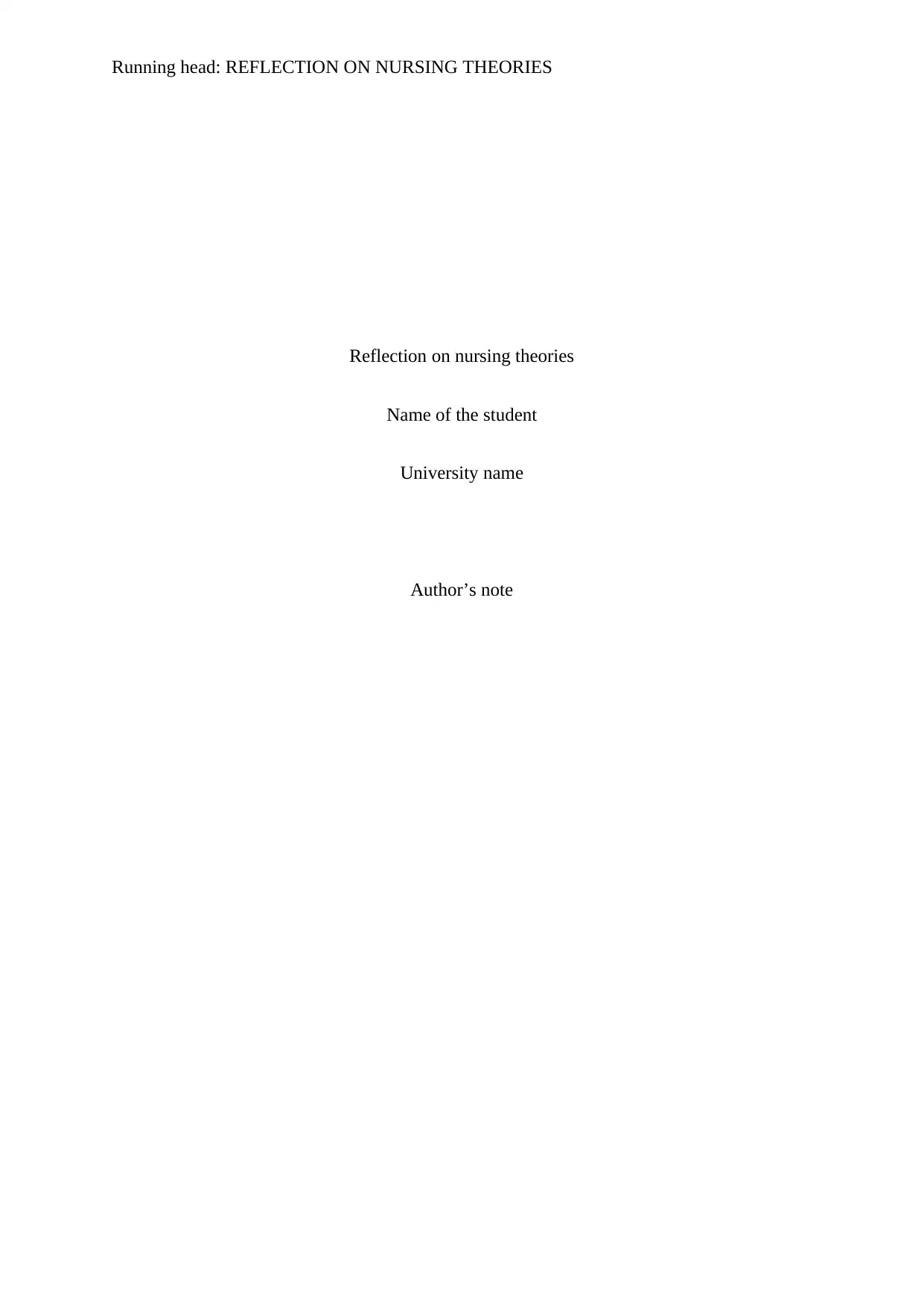
Running head: REFLECTION ON NURSING THEORIES
Reflection on nursing theories
Name of the student
University name
Author’s note
Reflection on nursing theories
Name of the student
University name
Author’s note
Paraphrase This Document
Need a fresh take? Get an instant paraphrase of this document with our AI Paraphraser
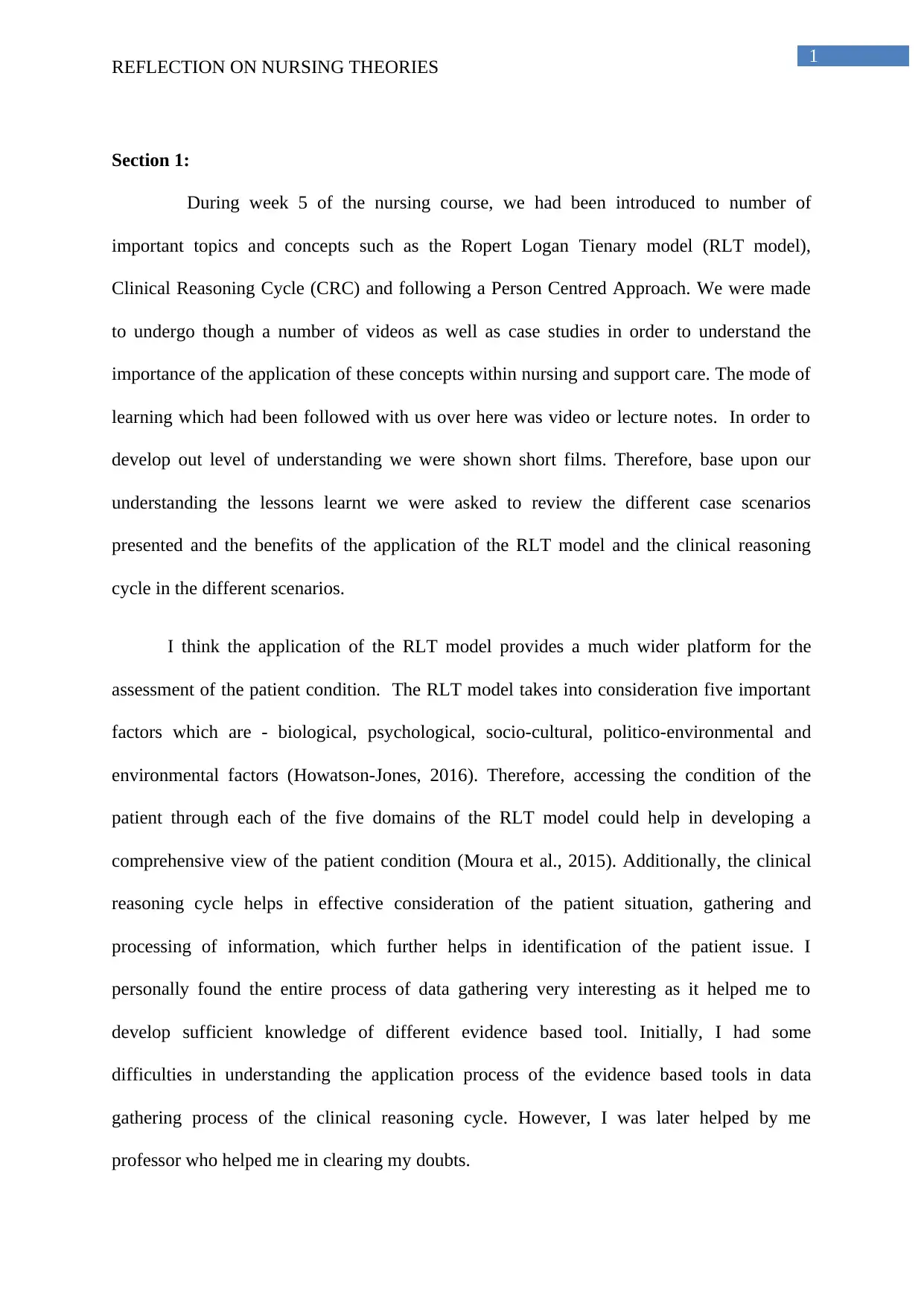
1
REFLECTION ON NURSING THEORIES
Section 1:
During week 5 of the nursing course, we had been introduced to number of
important topics and concepts such as the Ropert Logan Tienary model (RLT model),
Clinical Reasoning Cycle (CRC) and following a Person Centred Approach. We were made
to undergo though a number of videos as well as case studies in order to understand the
importance of the application of these concepts within nursing and support care. The mode of
learning which had been followed with us over here was video or lecture notes. In order to
develop out level of understanding we were shown short films. Therefore, base upon our
understanding the lessons learnt we were asked to review the different case scenarios
presented and the benefits of the application of the RLT model and the clinical reasoning
cycle in the different scenarios.
I think the application of the RLT model provides a much wider platform for the
assessment of the patient condition. The RLT model takes into consideration five important
factors which are - biological, psychological, socio-cultural, politico-environmental and
environmental factors (Howatson-Jones, 2016). Therefore, accessing the condition of the
patient through each of the five domains of the RLT model could help in developing a
comprehensive view of the patient condition (Moura et al., 2015). Additionally, the clinical
reasoning cycle helps in effective consideration of the patient situation, gathering and
processing of information, which further helps in identification of the patient issue. I
personally found the entire process of data gathering very interesting as it helped me to
develop sufficient knowledge of different evidence based tool. Initially, I had some
difficulties in understanding the application process of the evidence based tools in data
gathering process of the clinical reasoning cycle. However, I was later helped by me
professor who helped me in clearing my doubts.
REFLECTION ON NURSING THEORIES
Section 1:
During week 5 of the nursing course, we had been introduced to number of
important topics and concepts such as the Ropert Logan Tienary model (RLT model),
Clinical Reasoning Cycle (CRC) and following a Person Centred Approach. We were made
to undergo though a number of videos as well as case studies in order to understand the
importance of the application of these concepts within nursing and support care. The mode of
learning which had been followed with us over here was video or lecture notes. In order to
develop out level of understanding we were shown short films. Therefore, base upon our
understanding the lessons learnt we were asked to review the different case scenarios
presented and the benefits of the application of the RLT model and the clinical reasoning
cycle in the different scenarios.
I think the application of the RLT model provides a much wider platform for the
assessment of the patient condition. The RLT model takes into consideration five important
factors which are - biological, psychological, socio-cultural, politico-environmental and
environmental factors (Howatson-Jones, 2016). Therefore, accessing the condition of the
patient through each of the five domains of the RLT model could help in developing a
comprehensive view of the patient condition (Moura et al., 2015). Additionally, the clinical
reasoning cycle helps in effective consideration of the patient situation, gathering and
processing of information, which further helps in identification of the patient issue. I
personally found the entire process of data gathering very interesting as it helped me to
develop sufficient knowledge of different evidence based tool. Initially, I had some
difficulties in understanding the application process of the evidence based tools in data
gathering process of the clinical reasoning cycle. However, I was later helped by me
professor who helped me in clearing my doubts.
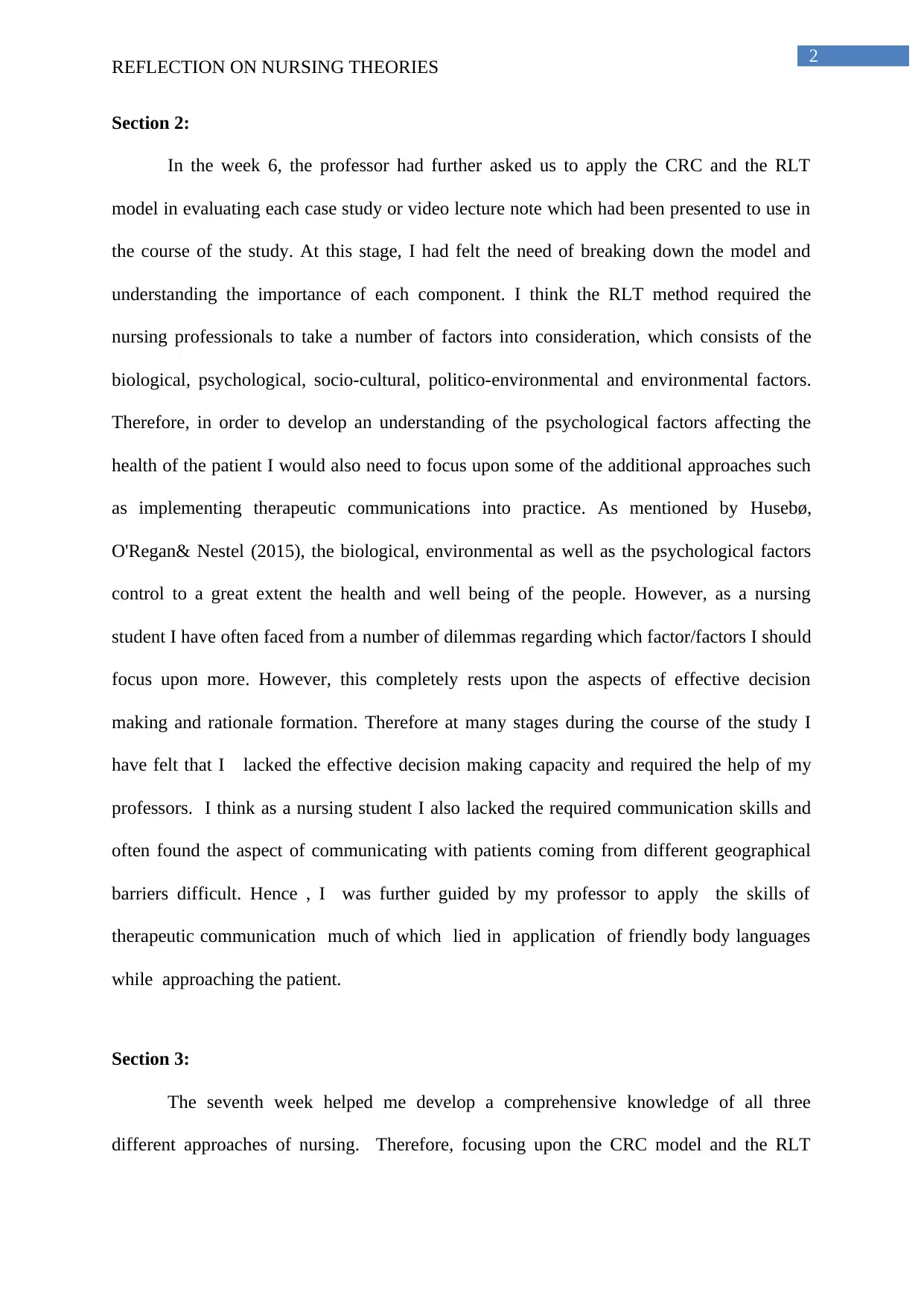
2
REFLECTION ON NURSING THEORIES
Section 2:
In the week 6, the professor had further asked us to apply the CRC and the RLT
model in evaluating each case study or video lecture note which had been presented to use in
the course of the study. At this stage, I had felt the need of breaking down the model and
understanding the importance of each component. I think the RLT method required the
nursing professionals to take a number of factors into consideration, which consists of the
biological, psychological, socio-cultural, politico-environmental and environmental factors.
Therefore, in order to develop an understanding of the psychological factors affecting the
health of the patient I would also need to focus upon some of the additional approaches such
as implementing therapeutic communications into practice. As mentioned by Husebø,
O'Regan& Nestel (2015), the biological, environmental as well as the psychological factors
control to a great extent the health and well being of the people. However, as a nursing
student I have often faced from a number of dilemmas regarding which factor/factors I should
focus upon more. However, this completely rests upon the aspects of effective decision
making and rationale formation. Therefore at many stages during the course of the study I
have felt that I lacked the effective decision making capacity and required the help of my
professors. I think as a nursing student I also lacked the required communication skills and
often found the aspect of communicating with patients coming from different geographical
barriers difficult. Hence , I was further guided by my professor to apply the skills of
therapeutic communication much of which lied in application of friendly body languages
while approaching the patient.
Section 3:
The seventh week helped me develop a comprehensive knowledge of all three
different approaches of nursing. Therefore, focusing upon the CRC model and the RLT
REFLECTION ON NURSING THEORIES
Section 2:
In the week 6, the professor had further asked us to apply the CRC and the RLT
model in evaluating each case study or video lecture note which had been presented to use in
the course of the study. At this stage, I had felt the need of breaking down the model and
understanding the importance of each component. I think the RLT method required the
nursing professionals to take a number of factors into consideration, which consists of the
biological, psychological, socio-cultural, politico-environmental and environmental factors.
Therefore, in order to develop an understanding of the psychological factors affecting the
health of the patient I would also need to focus upon some of the additional approaches such
as implementing therapeutic communications into practice. As mentioned by Husebø,
O'Regan& Nestel (2015), the biological, environmental as well as the psychological factors
control to a great extent the health and well being of the people. However, as a nursing
student I have often faced from a number of dilemmas regarding which factor/factors I should
focus upon more. However, this completely rests upon the aspects of effective decision
making and rationale formation. Therefore at many stages during the course of the study I
have felt that I lacked the effective decision making capacity and required the help of my
professors. I think as a nursing student I also lacked the required communication skills and
often found the aspect of communicating with patients coming from different geographical
barriers difficult. Hence , I was further guided by my professor to apply the skills of
therapeutic communication much of which lied in application of friendly body languages
while approaching the patient.
Section 3:
The seventh week helped me develop a comprehensive knowledge of all three
different approaches of nursing. Therefore, focusing upon the CRC model and the RLT
⊘ This is a preview!⊘
Do you want full access?
Subscribe today to unlock all pages.

Trusted by 1+ million students worldwide
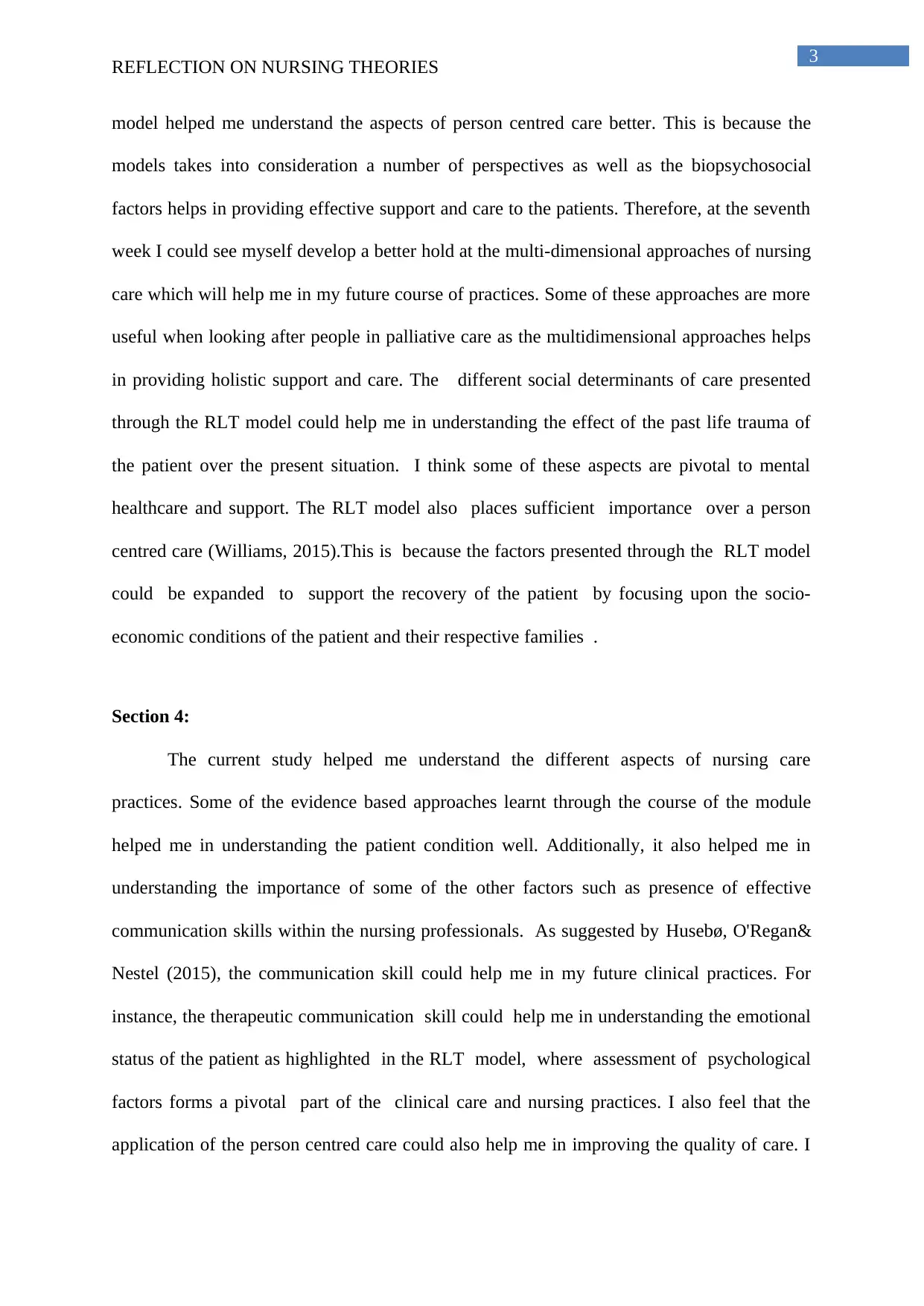
3
REFLECTION ON NURSING THEORIES
model helped me understand the aspects of person centred care better. This is because the
models takes into consideration a number of perspectives as well as the biopsychosocial
factors helps in providing effective support and care to the patients. Therefore, at the seventh
week I could see myself develop a better hold at the multi-dimensional approaches of nursing
care which will help me in my future course of practices. Some of these approaches are more
useful when looking after people in palliative care as the multidimensional approaches helps
in providing holistic support and care. The different social determinants of care presented
through the RLT model could help me in understanding the effect of the past life trauma of
the patient over the present situation. I think some of these aspects are pivotal to mental
healthcare and support. The RLT model also places sufficient importance over a person
centred care (Williams, 2015).This is because the factors presented through the RLT model
could be expanded to support the recovery of the patient by focusing upon the socio-
economic conditions of the patient and their respective families .
Section 4:
The current study helped me understand the different aspects of nursing care
practices. Some of the evidence based approaches learnt through the course of the module
helped me in understanding the patient condition well. Additionally, it also helped me in
understanding the importance of some of the other factors such as presence of effective
communication skills within the nursing professionals. As suggested by Husebø, O'Regan&
Nestel (2015), the communication skill could help me in my future clinical practices. For
instance, the therapeutic communication skill could help me in understanding the emotional
status of the patient as highlighted in the RLT model, where assessment of psychological
factors forms a pivotal part of the clinical care and nursing practices. I also feel that the
application of the person centred care could also help me in improving the quality of care. I
REFLECTION ON NURSING THEORIES
model helped me understand the aspects of person centred care better. This is because the
models takes into consideration a number of perspectives as well as the biopsychosocial
factors helps in providing effective support and care to the patients. Therefore, at the seventh
week I could see myself develop a better hold at the multi-dimensional approaches of nursing
care which will help me in my future course of practices. Some of these approaches are more
useful when looking after people in palliative care as the multidimensional approaches helps
in providing holistic support and care. The different social determinants of care presented
through the RLT model could help me in understanding the effect of the past life trauma of
the patient over the present situation. I think some of these aspects are pivotal to mental
healthcare and support. The RLT model also places sufficient importance over a person
centred care (Williams, 2015).This is because the factors presented through the RLT model
could be expanded to support the recovery of the patient by focusing upon the socio-
economic conditions of the patient and their respective families .
Section 4:
The current study helped me understand the different aspects of nursing care
practices. Some of the evidence based approaches learnt through the course of the module
helped me in understanding the patient condition well. Additionally, it also helped me in
understanding the importance of some of the other factors such as presence of effective
communication skills within the nursing professionals. As suggested by Husebø, O'Regan&
Nestel (2015), the communication skill could help me in my future clinical practices. For
instance, the therapeutic communication skill could help me in understanding the emotional
status of the patient as highlighted in the RLT model, where assessment of psychological
factors forms a pivotal part of the clinical care and nursing practices. I also feel that the
application of the person centred care could also help me in improving the quality of care. I
Paraphrase This Document
Need a fresh take? Get an instant paraphrase of this document with our AI Paraphraser

4
REFLECTION ON NURSING THEORIES
think one of the biggest aspects of the clinical reasoning cycle is that it helped me in
development of an effective nursing care plan based upon the present health status and
conditions of the patient. Additionally, the CRC could be used to learn regarding effective
note taking and documentation process which are pivotal to the making of an appropriate
healthcare plan (Moorhead, Johnson, Maas & Swanson, 2018). On the whole, I think the
entire learning session provided the students with sufficient branstorming activities which
helped us in developing effective decision making and judgemental skills. Additionally, the
entire learning session helped me focus upon my different strengths and weaknesses which
could help me emerge as a well trained nursing professional.
REFLECTION ON NURSING THEORIES
think one of the biggest aspects of the clinical reasoning cycle is that it helped me in
development of an effective nursing care plan based upon the present health status and
conditions of the patient. Additionally, the CRC could be used to learn regarding effective
note taking and documentation process which are pivotal to the making of an appropriate
healthcare plan (Moorhead, Johnson, Maas & Swanson, 2018). On the whole, I think the
entire learning session provided the students with sufficient branstorming activities which
helped us in developing effective decision making and judgemental skills. Additionally, the
entire learning session helped me focus upon my different strengths and weaknesses which
could help me emerge as a well trained nursing professional.
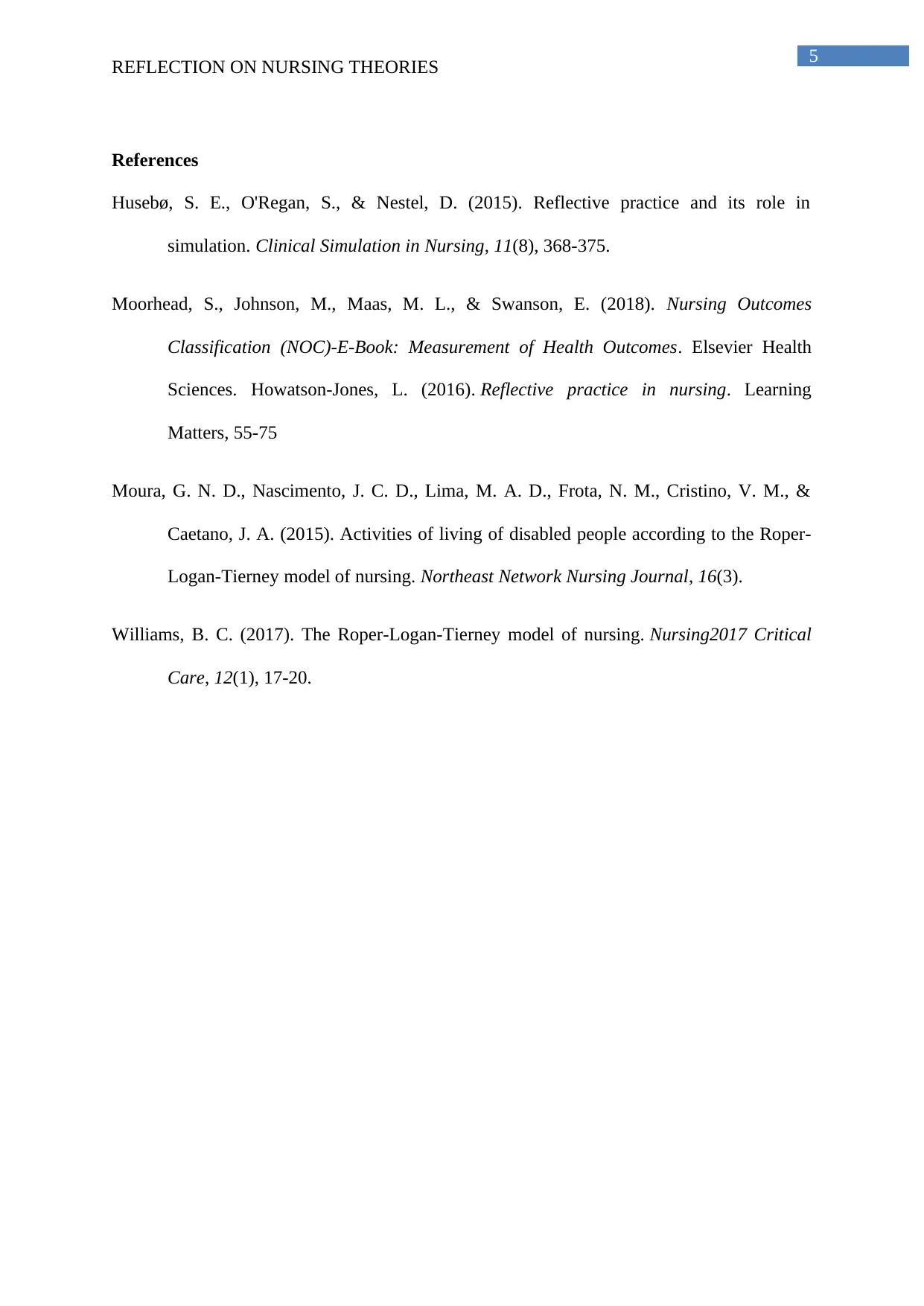
5
REFLECTION ON NURSING THEORIES
References
Husebø, S. E., O'Regan, S., & Nestel, D. (2015). Reflective practice and its role in
simulation. Clinical Simulation in Nursing, 11(8), 368-375.
Moorhead, S., Johnson, M., Maas, M. L., & Swanson, E. (2018). Nursing Outcomes
Classification (NOC)-E-Book: Measurement of Health Outcomes. Elsevier Health
Sciences. Howatson-Jones, L. (2016). Reflective practice in nursing. Learning
Matters, 55-75
Moura, G. N. D., Nascimento, J. C. D., Lima, M. A. D., Frota, N. M., Cristino, V. M., &
Caetano, J. A. (2015). Activities of living of disabled people according to the Roper-
Logan-Tierney model of nursing. Northeast Network Nursing Journal, 16(3).
Williams, B. C. (2017). The Roper-Logan-Tierney model of nursing. Nursing2017 Critical
Care, 12(1), 17-20.
REFLECTION ON NURSING THEORIES
References
Husebø, S. E., O'Regan, S., & Nestel, D. (2015). Reflective practice and its role in
simulation. Clinical Simulation in Nursing, 11(8), 368-375.
Moorhead, S., Johnson, M., Maas, M. L., & Swanson, E. (2018). Nursing Outcomes
Classification (NOC)-E-Book: Measurement of Health Outcomes. Elsevier Health
Sciences. Howatson-Jones, L. (2016). Reflective practice in nursing. Learning
Matters, 55-75
Moura, G. N. D., Nascimento, J. C. D., Lima, M. A. D., Frota, N. M., Cristino, V. M., &
Caetano, J. A. (2015). Activities of living of disabled people according to the Roper-
Logan-Tierney model of nursing. Northeast Network Nursing Journal, 16(3).
Williams, B. C. (2017). The Roper-Logan-Tierney model of nursing. Nursing2017 Critical
Care, 12(1), 17-20.
⊘ This is a preview!⊘
Do you want full access?
Subscribe today to unlock all pages.

Trusted by 1+ million students worldwide
1 out of 6
Related Documents
Your All-in-One AI-Powered Toolkit for Academic Success.
+13062052269
info@desklib.com
Available 24*7 on WhatsApp / Email
![[object Object]](/_next/static/media/star-bottom.7253800d.svg)
Unlock your academic potential
Copyright © 2020–2025 A2Z Services. All Rights Reserved. Developed and managed by ZUCOL.




